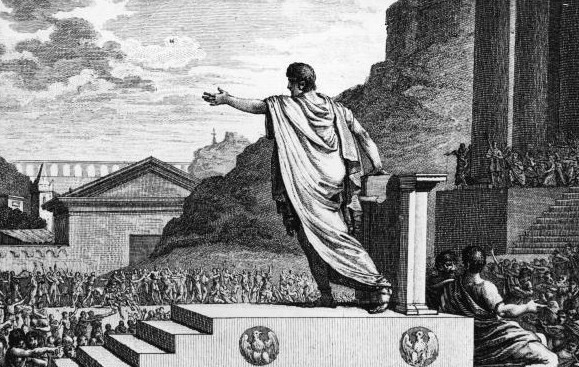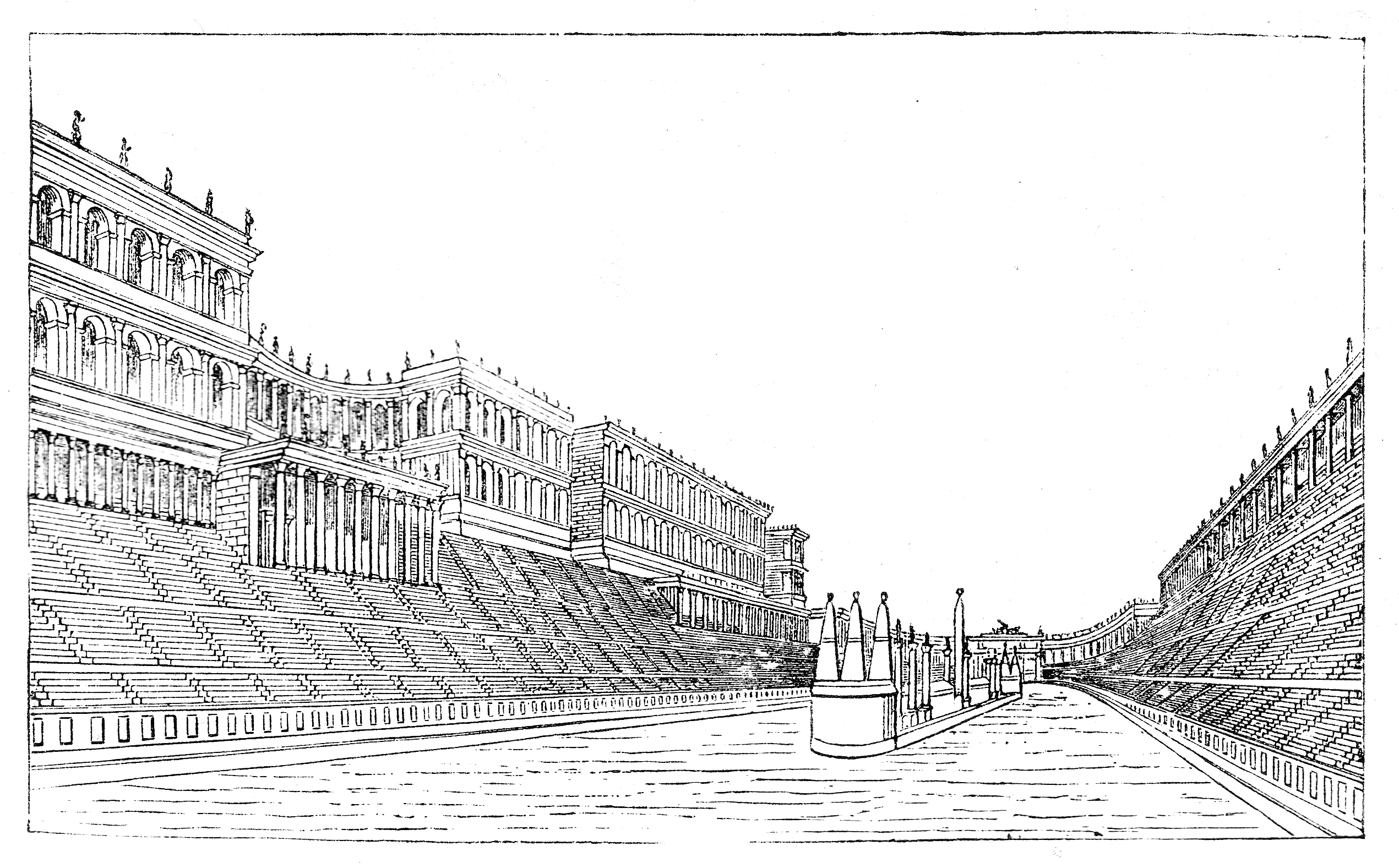Gladiators
Seating in the Arena and Society
In this section you will learn
- How seating in Roman arenas and theatres went from being mixed gender and with different classes sitting next to or close to each other to being highly organized according to rank by the Emperor Augustus and others.
- About the exclusion of Roman women from some events, and their placement at the back of the arena for others
- The unique status of chariot racing which allowed men and women of all classes to sit together

Rome was an incredibly hierarchical society and eventually seating evolved to show that in detail. Although seating was fairly indiscriminate in the early days of games and festivals, gradually over time separate seating sections were created for senators and then equestrians in the various theatres, amphitheatres, and Circus Maximus. In 194 BCE seating[1] was set aside for the Senate at performances, segregating them from the common people.
Atilius Serranus and L. Scribonius Libo were the first aediles who brought dramas to the Ludi Megalenses. It was when these same aediles held the Ludi Romani that the Senate for the first time sat apart from the people. This, like all innovations, generated a great deal of comment. Some regarded it as a tribute which had long been due to the highest order in the Republic; others considered that whatever enhanced the greatness of the patricians detracted from the dignity of the people, and that all such distinctions as mark off the different orders in the State impair the concord and liberty which all ought equally to enjoy. For 557 years the spectators had sat wherever they wanted, what, people asked, had happened all of a sudden that the patricians refused to have the plebeians amongst them? Why should a rich man object to a poor man sitting by his side? It was a piece of unheard-of arrogance neither adopted nor wished for by any other Senate in the world. Even [Scipio] Africanus himself, who when consul was responsible for the change, was said to have regretted it. So distasteful is any departure from past behaviour; so much do men prefer to cling to the old ways except where they are clearly condemned by experience.
Livy, From the Founding of the City 34.54
As seating became more restricted some politicians courted the people by tearing down the expensive seats. Gaius Gracchus, a tribune of the plebs in 123 and 122, did just this; although popular with the people, it was less popular with other elites.
Moreover, it happened that Gaius had incurred the anger of the other tribunes, for the following reason. The people were going to enjoy an exhibition of gladiators in the Forum, and most of the magistrates had constructed seats for the show round about, and were offering them for a fee. Gaius ordered them to take down these seats, so the poor could to enjoy the spectacle from those places without paying. But since no one paid any attention to his command, he waited till the night before the spectacle, and then, taking all the workmen whom he had under his orders in public contracts, he pulled down the seats, and when day came he had the place all clear for the people. Because of this the people thought him a man, but his colleagues were annoyed and thought him reckless and violent. It was believed also that this conduct cost him his election to the tribunate for the third time, since, although he got a majority of the votes, his colleagues were unjust and fraudulent in their proclamation and returns. This, however, was disputed.
Plutarch, Gaius Gracchus 12.3-4

In 67 BCE 14 rows of seats were set aside in the theatre for equestrians under the Lex Roscia,a law proposed by Marcus Otho Roscius, a tribune of the plebs. This was not popular with the people, though it was with the equestrians. (Bankrupt equestrians were made to sit in a different section.)
In earlier times, it seems, the men of the equestrian order were mixed in with the mob in the theatres and saw the spectacles along with the people, seated as luck would have it; Marcus Otho was the first to separate in point of honour the equestrians from the rest of the citizens, which he did when he was praetor, and gave them a particular place of their own at the spectacles, which they still keep. 3 The people took this as an insult to themselves, and when Otho appeared in the theatre they hissed him insultingly, while the equestrians greeted him with loud applause. The people renewed and increased their hisses, and then the equestrians their applause.
Plutarch, Cicero 13
Augustus, who was concerned with reforming Rome after the political, social, and military chaos of the Late Republic, completely stratified audiences at theatrical and gladiatorial shows. He not only reaffirmed the old seating rules in a law passed sometime after 5 CE, the lex Julia theatralis, but added new ones and moved women to the back rows, although previously they had sat with their families.
At the elections for tribunes if there were not candidates enough of senatorial rank, Augustus made appointments from among the equestrians, with the understanding that after their term they might remain in whichever order they wished. Moreover, since many equestrians whose property was diminished during the civil wars did not dare to view the games from the fourteen rows through fear of the penalty of the law regarding theatres, he declared that none were liable to its provisions, if they themselves or their parents had ever possessed a equestrian’s estate.
Suetonius, Augustus 44
Using special regulations he ended the disorderly, haphazard fashion of viewing the games; he did this because he was unhappy at the insult to a senator, to whom no one offered a seat in a crowded arena at some very heavily attended games in Puteoli. Because of this the Senate decreed that, whenever any public show was given anywhere, the first row of seats should be reserved for senators. At Rome Augustus would not allow the ambassadors of the free and allied nations to sit in the orchestra, since he was told that sometimes freedmen bought those positions. He separated the army from the people. He assigned special seats to the married men of the plebs, gave their own section to underage boys and the adjoining one to their teachers; and he decreed that no one wearing a dark cloak should sit in the middle of the audience. He would not allow women to view even the gladiators except from the upper seats, though it had been the custom for men and women to sit together at such shows. Only the Vestal Virgins were assigned a place to themselves, opposite the praetor’s tribunal.[2] As for the athletic contests,[3] he excluded women from them so strictly, that when a contest between a pair of boxers had been called for at the games in honour of his appointment as Pontifex Maximus,[4] he postponed it until early the following day, making proclamation that it was his desire that women should not come to the theatre before the fifth hour.
Suetonius Augustus 44.1-3
Nero added separate seating for the equestrians in the Circus Maximus, where previously they had sat with the crowd.
He gave many different types of entertainments: the Juvenalia;[5] chariot races in the Circus; plays; and a gladiatorial show. At the Juvenalia he had even old men of consular rank and aged matrons take part. For the games in the Circus he gave seats to the equestrians apart from the rest of the people, and even raced chariots drawn by four camels against each other.
Suetonius, Nero 11.1

Spectators in the Colosseum were supposed to wear togas in the lower seats; those who could only afford dark clothing were relegated to the back. When the emperor attended it was especially important to make an effort, and wear the heavy hot toga – and that went double for members of the senate. In the following poem we hear of a poor man who went to the arena in dark clothes and thanks to a snow shower in the middle found himself in white:[6]
A second ago, Horatius was watching the games, the only one there wearing in a dark outfit, while the plebs and the lower and highest classes along with our shining leader were sitting dressed in white. Suddenly snow fell from all over the sky; now Horatius watches dressed in white.
Martial, Epigrams 4.2
Bibliography and Further Reading
- Fagan, Garrett. 2011. The Lure of the Arena. Cambridge: 80-96.
- Gutierrez, Diego, et al. 2007. “AI and virtual crowds: Populating the Colosseum.” Journal of Cultural Heritage 8:176–185. Very interesting study that shows how crowds would have moved (or hit bottlenecks) in the arena.
- Rawson, Elizabeth. 1987. “Discrimina ordinum: The Lex Julia theatralis.” Papers of the British School at Rome 55:83–114
- Rose, Peter. 2005. “Spectators and spectator comfort in Roman entertainment buildings: A study in functional design.” Papers of the British School at Rome 73:99–130
Media Attributions
- Colosseum-profile-english © Photo by Ningyou is licensed under a Public Domain license
- Gaius Gracchus Tribune of the People © Silvestre David Mirys is licensed under a Public Domain license
- Illustrerad Verldshistoria band II Ill 026 © Ernst Wallis et al is licensed under a Public Domain license
- It is important to remember that Rome had no permanent theatre, so we are frequently referring to seats set up in an ad hoc fashion, around the Forum and on the steps of temples and various buildings. ↵
- The praetor’s box would become the imperial box at the Colosseum; the Vestals had their own box facing it. (We are not sure of the exact location of either box.) ↵
- Greek athletics at which athletes were naked. ↵
- The Chief Priest of Rome. Augustus took the position in 13 BCE after the death of Marcus Aemilius Lepidus, the triumvir, who had held the position from 44. ↵
- This festival, instituted by Nero in 59 BCE when he was, commemorated the first time he had shaved his beard. ↵
- This is a bit wittier of a poem in Latin, but not much. ↵
The first rank on the cursus honorum, the course of public offices, these magistrates were in charge of maintaining public buildings and space and supervised and organized the public festivals. There were two types of aedile, curule, and plebeian.
Also known as the Megalesia. Held in April (almost at the same time as the Ludi Cereales, first celebrated in 204 BCE with the coming of the Magna Mater, the Great Mother from Pessinus in modern Turkey (Livy 29.14.14), it became an annual festival in 194 BCE. It involved ludi scaenici for one of its six days.
In honor of Juppiter Optimus Maximus. The ludi scaenici were added to this festival in 364 BCE, and by 214 they covered four days (Livy 24.43.7); it was here that Livius Andronicus presented the first recorded play at Rome.
A magistracy without imperium, it was founded in 494 BCE to protect the interests of the plebs. It was a sacrosanct office – meaning that harming one in office was a capital offence – and from 449 BCE onwards any tribune could veto any legislation that he felt was not in the interest of the people. Originally there were only two, but that number expanded to ten; their powers were circumscribed by the Dictator Sulla, but quickly restored by Pompey the Great in 54 BCE.
The second most senior position in the cursus honorum, there was originally only one, but the number expanded to 8 and then 16 as the needs of the administration demanded more and more magistrates.
The chief military and civilian commander of Rome. Two were elected each year and competition to become consul was incredibly intense as it represented the apex of a political career. After their term in office consuls could go on to be governors of provinces, where, under the Republic, they were wont to rob the provincials blind in order to recoup the costs of their political campaigns.

